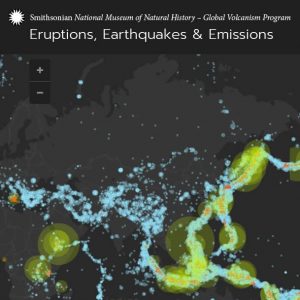 Smithsonian.com reported on the Global Volcanism Program, a study of the inner workings of volcanoes. Simon Carn (GMES) is one of the program’s researchers.
Smithsonian.com reported on the Global Volcanism Program, a study of the inner workings of volcanoes. Simon Carn (GMES) is one of the program’s researchers.
How Earthquakes and Volcanoes Reveal the Beating Heart of the Planet
The Smithsonian Global Volcanism Program has stitched together a visual archive of the world’s earthquakes and volcanoes
To illustrate these dynamic patterns, the Smithsonian Institution’s Global Volcanism Program, hosted within the National Museum of Natural History, has created a time-lapse animation of the world’s earthquakes, eruptions and emissions since 1960. Drawing from the first compiled database of sulfur emissions dating to 1978, the animations show how the seemingly random activity of volcanoes and earthquakes form consistent global patterns over time. Understanding those patterns gives researchers insight into how these dramatic events are entwined with the inner workings of our planet.
Earthquakes and volcanoes can conjure up images of widespread destruction. But for those who study Earth’s deepest reaches, like Elizabeth Cottrell, a research geologist at the Smithsonian’s National Museum of Natural History and director of the Global Volcanism Program, volcanoes are also “windows to the interior.”
“Global satellite monitoring of volcanoes will transform our understanding of gas fluxes from Earth’s interior to exterior in the coming decade,” says Cottrell, who has been working along with Michigan Tech researcher Simon Carn and data manager Ed Venzke to incorporate volcanic emissions into the Smithsonian database since 2012.